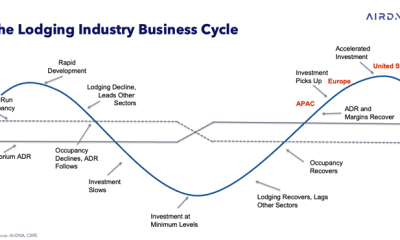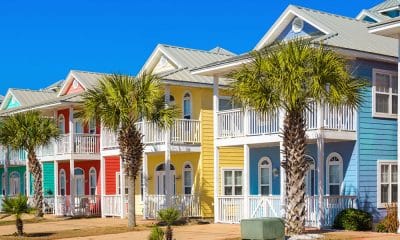
Occupancy has consistently been used as a staple indicator of performance for hoteliers and rental managers.
Because occupancy rates are one of the most useful metrics for a revenue manager, and a tool adopted from hoteliers, we tend to pursue high occupancy rates. The fewer vacancies we have, the more money we make, which, in turn, means happier owners. However, this is not always the case. Let us examine the differences between hotel and vacation rental occupancy, methods for calculating occupancy, and why maximizing occupancy should not be the final goal.
Hoteliers are decades ahead of vacation rental managers in terms of revenue management. As a result, vacation rental revenue managers have borrowed many strategies—including measuring the occupancy rate—from hotel revenue managers. But, as we now know, hotels and vacation rentals are different industries. Vacation rentals deal with more nuanced booking windows, a variety of inventories, and a traditionally different clientele.
Perhaps the most obvious difference is that hotels do not have owners booking stays in their rooms. These stays, typically non-revenue-producing except for the occasional cleaning fee, sometimes dramatically reduce the number of days available for booking. Factoring in vacation rental owners alters the occupancy rate in an essential way: They change the number of nights a property manager is able to book.
The traditional occupancy rate is measured by taking the total number of nights sold and dividing by the total number of nights in the period. If we manage 10 units during September, and have sold 100 nights, the calculation would be as follows:
Occupancy Rate
100 nights sold / (10 units x 30 nights) = 33% occupied
In other words, on an average night during September, we filled one third of our properties with guests. This method of occupancy calculation is typically how hotels track performance and vacancy. It may appear to be the best way to determine how well a revenue manager performed during a given time, but it fails to take those important owner nights into account.
Now, if these 10 owners are staying for 50 total nights in September, those nights are unavailable to guests. If owner nights are included in the nights available to book, it is not a fair assessment of how well the property managers performed. We prefer to take them out of the denominator, which brings the rate closer to an actual representation of available nights.
100 nights sold / ([10 units x 30 nights] – 50 owner nights)
= 40% occupied
If owner’s stays are excluded from the occupancy rate, the percentage changes drastically—from 33 percent to 40 percent. Suddenly, it seems as though we are doing a better job of filling our properties. At Key Data, we take this a step further; if owner nights are excluded from available nights, maintenance holds should also be removed, because they detract from the nights available to guests. When maintenance holds are considered, the occupancy rate continues to grow.
Adjusted Paid Occupancy Percentage
100 nights sold / ([10 units x 30 nights] – 50 owner nights – 25 holds) = 45% occupied
This occupancy rate is called the adjusted paid occupancy percentage, because it only includes paid nights and adjusts the denominator to consider only nights available to guests. Although that traditional occupancy rate may be helpful for the KPI to consider, adjusted paid occupancy percentage allows property managers to look at occupancy from an angle that excludes factors beyond their control. Because the rate of owner stays and maintenance holds varies greatly from property to property, the adjusted paid occupancy percentage is useful for comparing similar inventories and is essential when benchmarking performance against competitors.
It is difficult to determine when a competitor’s properties are unavailable to book because they are already reserved or whether there is an owner stay/maintenance hold. Removing owner stays and maintenance holds allows for a true apples-to-apples comparison.
No matter the calculation method, revenue managers generally aim for a high occupancy rate. However, extremely high occupancy leads to unit wear and tear and leaves a small window for cleaning, maintenance, and larger updates. Property managers also risk leaving revenue on the table, because high occupancy can indicate that prices are too low. Thus, when combined with other KPIs, the occupancy rate becomes a more valuable tool.
By combining occupancy and average daily rate (ADR) revenue managers can calculate their revenue per available rental (RevPAR), which is arguably the most powerful KPI in the business. occupancy alone answers the question, “How many nights are booked?” ADR answers the question, “At what rate were my nights booked?” Answering only one of those questions fails to reveal the whole picture. After all, what if you could make more money by charging more for your rentals, even though you had fewer guests? This is where RevPAR comes in.
Revenue Per Available Rental
Occupancy x ADR = RevPAR
Scenario 1: 90% Occupancy Rate x $150 ADR = $135 RevPAR
Scenario 2: 75% Occupancy Rate x $200 ADR = $160 RevPAR
Even though occupancy is higher in Scenario 1, RevPAR is lower, indicating that additional revenue can be made by raising prices. When calculated using adjusted paid occupancy percentage, this becomes a vacation rental-specific KPI: Adjusted RevPAR. This KPI is a step above hotels’ idea of RevPAR and accommodates the intricacies of vacation rentals. A critical KPI for measuring revenue performance, adjusted RevPAR accounts for both ADR and the paid occupancy percentage. Adjusted RevPAR will usually be higher than RevPAR because owner stays and maintenance holds are considered, making it ideal for comparative purposes.
Adjusted Revenue Per Available Rental
Adjusted Paid Occupancy x ADR = Adjusted RevPAR
Adjusted Paid Occupancy = 40%
ADR = $150
Adjusted RevPAR = $60
Occupancy = 33%
ADR = $150
RevPAR = $50
We work in a dynamic industry and are building the playbook as we go. As we continue coming into our own we should consider adopting the calculations and data sources that best set up our industry for success. Seemingly small differences, like changing our occupancy calculations, can have large impacts; as we continue sharing our ideas, we will find how to best measure performance. The decisions property management companies make about pricing are fundamental to their success. As we continue growing in our space together it is critical that decisions are not just data-driven but driven by high-quality data, calculated using methods optimized for the industry.












How do you account for paid cancellations? Can occupancy rate be more than 100% if you sell certain days twice due to paid cancellations?